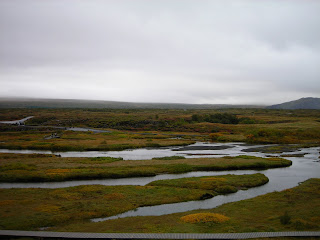Fyrirgefþu, þessi er rollan mín. (Excuse me, that is my sheep.)
Considering I’ve only been here two weeks now, I’d say I’m doing pretty well in terms of experiencing what makes Iceland “Iceland.” This past week, I visited one of the country’s famed thermal pools, I observed (“got right in the middle of” is a better phrase) one of the oldest continuous social customs in this part of the world, and visited what is termed the Golden Circle—very much a circle inhabited more by tourists than by Icelanders, but still, it’s culture.

The thermal pools: wonderful! I don’t have any pictures of the experience because, really, who wants to risk dunking the camera? So here's a pretty rainbow. But if you are ever in Iceland, do visit a thermal pool; every single town has one, many heated by natural springs and almost all outdoors. There are stories of Icelandic politicians (medieval and modern) holding counsel with visiting dignitaries while soaking in their “hot pot.” But there’s something exhilarating about running across the pool yard, wet and freezing cold in the constant Icelandic wind, then slipping into the hot tub to soak alongside Icelanders of all shapes and sizes, while the steam swirls up from the surface and the rain falls on your face. Honestly I thought it would be about as awful as it sounds, but it was terrific! And as one of Iceland’s national pastimes, it also happens to be one of the only inexpensive things to do in one’s leisure hours!

The social custom: the réttir (the annual sheep round-up)! With no natural predators and no particular reason to be paranoid, the Icelandic farmers let their sheep free-range in the hills all summer, and round them up in the fall to be sorted and taken in for the winter (well, the ones they don’t eat). The University organized a tour to a nearby réttir, and five of us from my program went along. They get the sheep into a big central pen (this one was built of lava rocks over a hundred years ago), then wade in amongst them, check their ear tags, and drag them over to the chute that belongs to the proper farmer. The chutes are arranged around the pen like spokes on a wheel. And it’s not just farmers who dive in: regular suburban Icelanders drive out to the réttir, put on galoshes, and start sorting right along with the farmers—even kids as young as five or six!

We happened to be in the pen when they delivered a new group of animals, and it was so packed with people and fluffy critters that we couldn’t get back out! I was literally knee-deep in sheep for about five minutes. It was unreal.

There were also many Icelandic horses there, some of which are allowed to range with the sheep during the summer, and some of which just happened to be kept there while people rode to and from the réttir (apparently this is a popular tourist option). Needless to say, I made some friends. And took a lot of pictures.

The Golden Circle: Gullfoss, Geysir, and Þingvellir. After the réttir, we climbed back on the bus (smelling strongly of sheep, by the bye) and drove to Gullfoss, the “Golden Waterfall.” Iceland has thousands of waterfalls, but Gullfoss is one of the most picturesque—not to mention the most accessible from Reykjavík. It’s no Niagara Falls, but I always thought Niagara was a little showy anyway. Gullfoss was nearly destroyed by attempts to build a power plant on top of it, but fortunately a woman named Sigriður, whose family owned the land nearby, managed to pressure the power company into abandoning the project (and the thanks she gets is that some people blame her for single-handedly delaying the modern age in Iceland).

Like the Irish, the Icelanders have not yet reached the point where they feel they have to fence off everything that might be mildly hazardous; in fact, the low-lying ropes that they put to keep people away from dangerous precipices really would be more effective at tripping you and sending you headlong over the edge if you weren’t paying attention than actually stopping you from falling.
Geysir, as you might guess, is the geyser from which all “spouting springs” take their name. It used to erupt regularly, but now, like poor Old Faithful, it has lost its oomph and is now just a very hot spring. However, Stokkur (I was told it means “butter churn”) is still quite feisty, and spouts about ten meters high every five minutes or so. What is really terrific is the aqua-blue bubble that forms right before the spout, but you just try taking a good picture of that with a digital camera.

Þingvellir (the first letter is the Thorn rune from Old English, pronounced “th”), or the Parliament Plains, are both the divide between the American and Eurasian continental shelves and the location where the Icelanders held their Althing—their judicial parliament—every year for a millennium, give or take.

I’m not the kind of person to get particularly excited about governmental history, but to say you’ve stood (more or less) on the very spot where a nation voted a thousand years ago to convert (again, more or less) from paganism to Christianity, that’s something. And the whole place looks like Middle Earth anyway, so a Tolkien fan can’t lose!
This is a very long post at this point, but as I don’t anticipate any more trips for awhile (the weather is starting to get very windy and rainy), it might be the last one of any interest—not to mention length—for some time! So until something exciting happens, cheers!


No comments:
Post a Comment